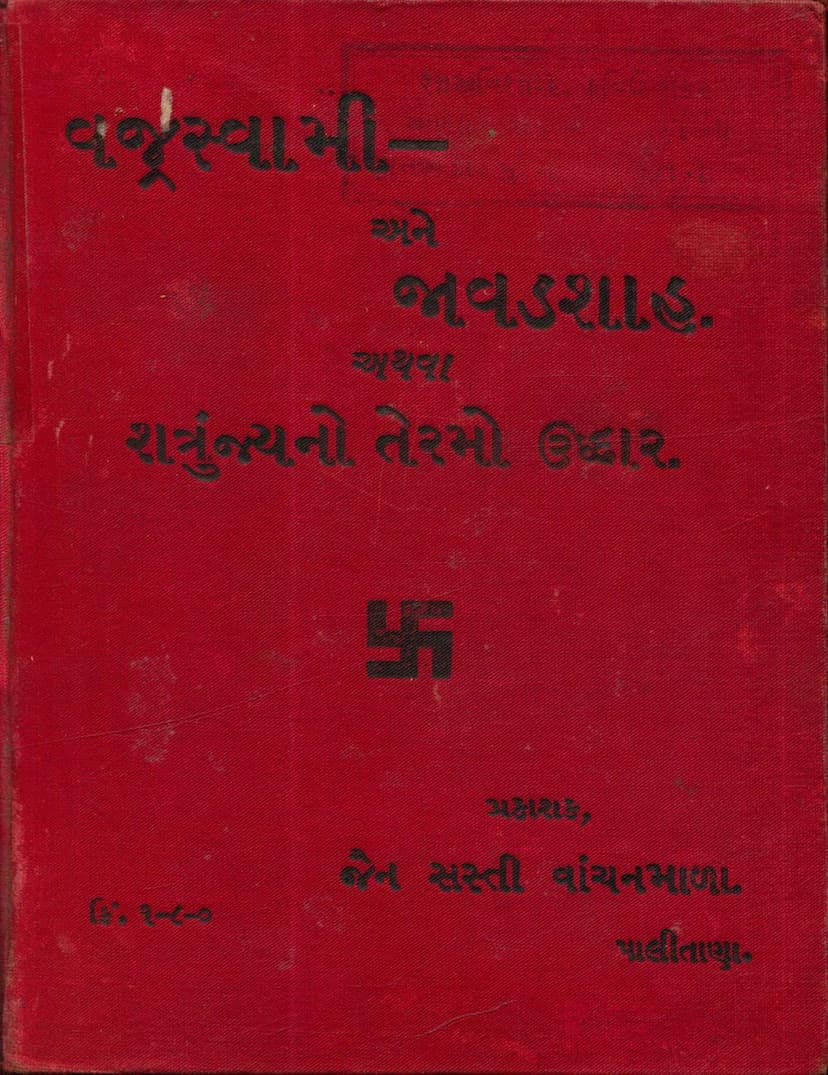Vajraswami Ane Jawad Shah Athva Shatrunjay 13 Mo Uddhar
Added to library: September 2, 2025

Summary
The book "Vajraswami Ane Jawad Shah Athva Shatrunjay 13 Mo Uddhar" by Manilal Nyalchand, published by Jain Sasti Vanchanmala, is a historical and religious narrative centered around the Jain pilgrimage site of Shatrunjay. The text, presented in Gujarati, recounts events related to the purification and restoration (Uddhar) of the Shatrunjay hill, specifically highlighting the 13th such restoration.
The book begins with a dedication to the late Vijuben, described as a mother-figure, and expresses gratitude for her virtues and religious devotion. The author acknowledges Babu Bhagwanlalji for his support by purchasing 200 copies of the book.
A concise biography of Sva. Vijuben follows, portraying her as a virtuous woman from a respected family in Patan. Despite her affluent background and status, she maintained simplicity, detachment from wealth, and a deep devotion to religion. Her life is presented as an example for others.
The introductory sections also express the publisher's commitment to Jain literature and other historical and educational books. They encourage readers to support their efforts.
The narrative then delves into the historical significance of Shatrunjay, a sacred pilgrimage site for Jains. It details a period in the 1st century of the Vikram era when Shatrunjay was desecrated by demons, making pilgrimage impossible. It was during this dire time that Jawad Shah, with the help of Vajraswami, is credited with overcoming the demonic forces and reopening the path to Shatrunjay. The book is presented as a thoroughly researched and engaging story, written in a captivating style.
The text further elaborates on the importance of studying history to instill courage and pride in the younger generation and to bridge the gap between ancient glory and modern progress.
The main narrative focuses on the story of Vajraswami and Jawad Shah in their endeavor to restore Shatrunjay. The early chapters introduce the concept of societal reliance on wealth and the struggles faced by the impoverished protagonist, Bhavad Shah, and his wife Bhagyamati. Their journey from poverty to prosperity is intricately woven with themes of dharma, perseverance, and divine grace, particularly through devotion to Lord Parshvanath and the auspicious dream of Lakshmi Devi.
The story progresses through Bhavad Shah's business ventures, the birth of his son Jawad Shah, and the challenges they face, including the machinations of envious individuals. Jawad Shah's virtuous character, business acumen, and religious devotion are highlighted as he overcomes obstacles and brings prosperity to his family and community.
A significant portion of the narrative is dedicated to the historical context of Jainism, mentioning the presence of Jainism in various countries and the roles of prominent figures like King Vikramaditya and his devotion to Lord Parshvanath. The text also recounts the history of Shatrunjay's numerous restorations, emphasizing the efforts of various rulers and devout individuals throughout different eras.
The latter part of the book details the challenges faced by Shatrunjay, including the desecration by demons and the efforts of Vajraswami and Jawad Shah to overcome these obstacles. The narrative emphasizes the importance of faith, perseverance, and divine intervention in achieving righteous goals. The book highlights the virtues of the protagonists, their commitment to Jain principles, and their role in revitalizing the sacred site of Shatrunjay.
The text also touches upon the concept of karma, the cyclical nature of life, and the importance of righteous conduct in achieving spiritual liberation. The stories of various historical figures and their devotion are presented to illustrate these principles.
In essence, the book "Vajraswami Ane Jawad Shah Athva Shatrunjay 13 Mo Uddhar" is a devotional and historical account that aims to inspire readers with tales of faith, righteousness, and the enduring significance of Jain pilgrimage sites. It emphasizes the power of devotion, the importance of virtue, and the eventual triumph of good over evil, all set against the backdrop of the sacred Shatrunjay hill.